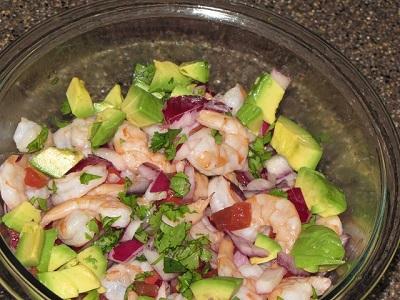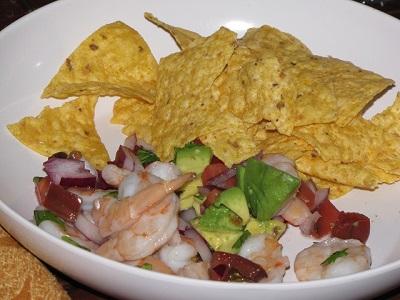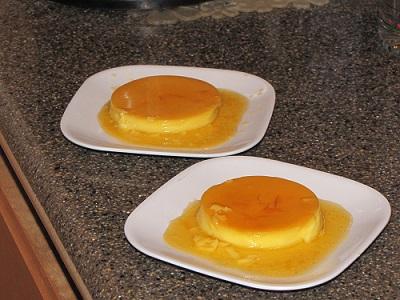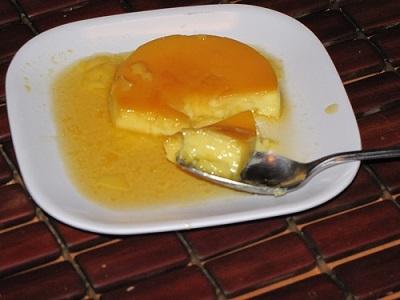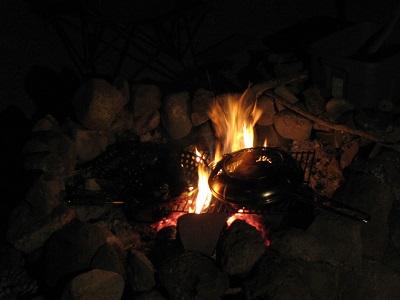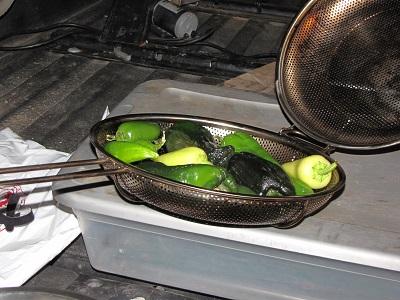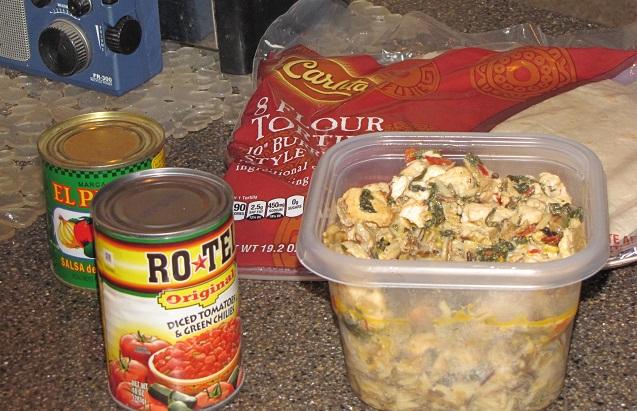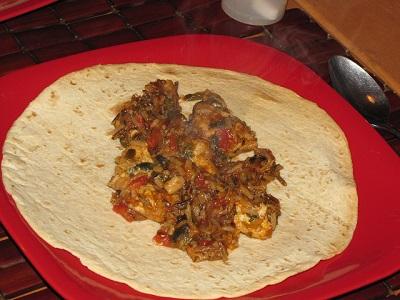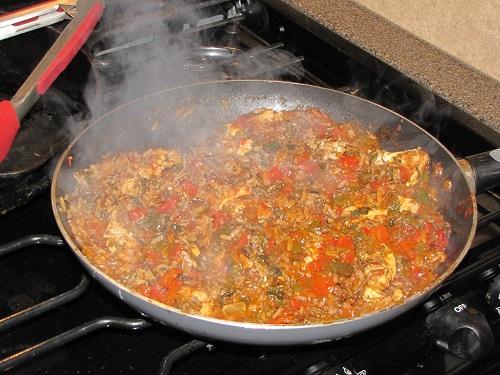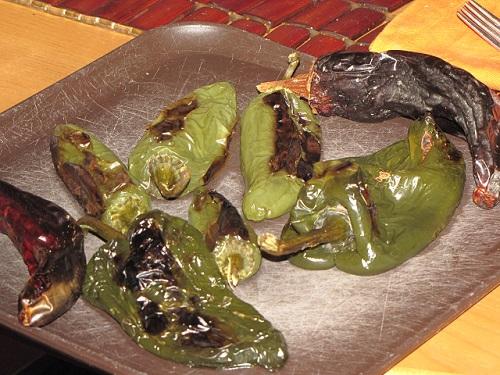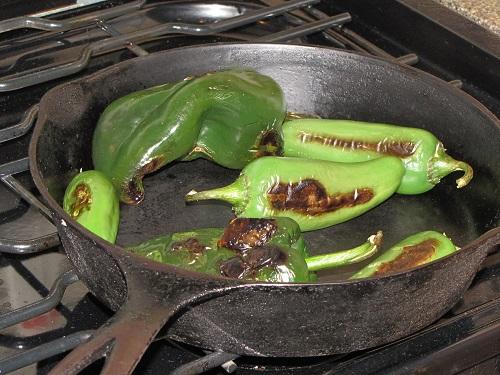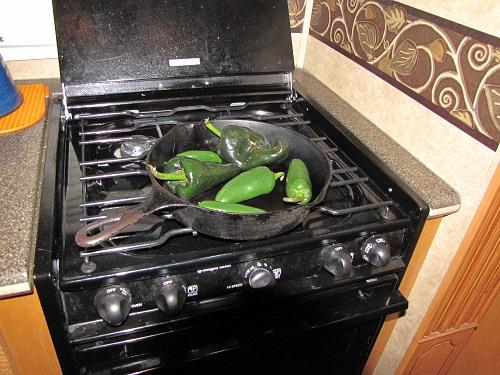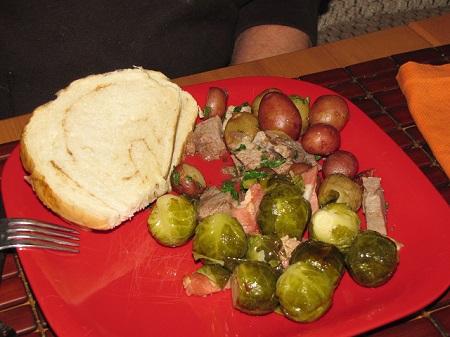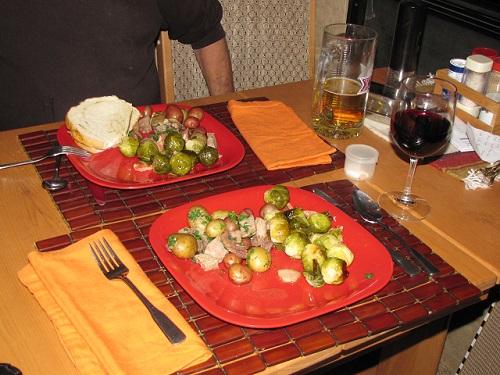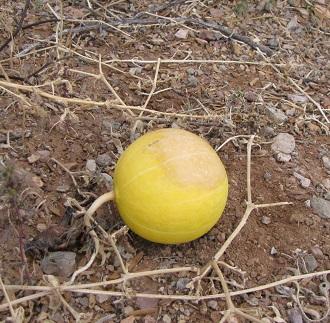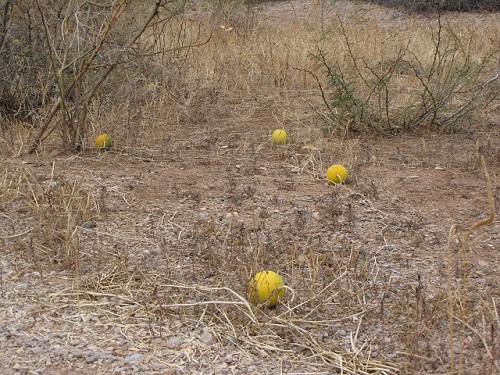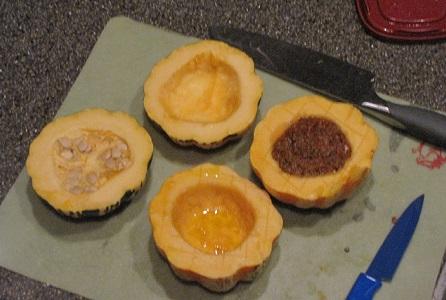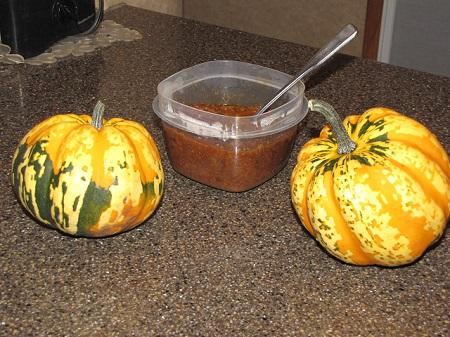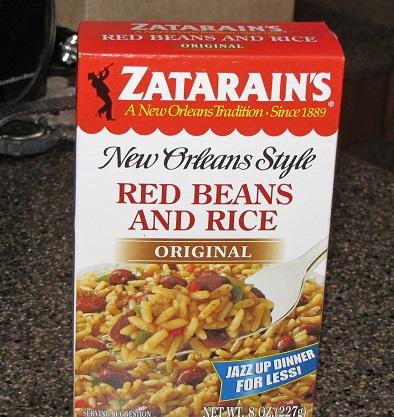-
Posts
13,559 -
Joined
-
Last visited
Content Type
Profiles
Forums
Store
Help Articles
Everything posted by Smithy
-
I wouldn't worry much about residual detergent tastes if you follow the instructions ElsieD posted above. Another idea, if you're worried about residual fats or oils, is to sprinkle flour or cornstarch as an absorbent, then scrape, then clean as noted above. I don't know about you, but when I'm rolling doughs out on my granite top I'm already using a bit of flour for that "lightly floured surface". FWIW my granite countertop instructions also said to avoid ammonia-based cleaners because they'd mar the finish over time. I don't know whether that would also apply to marble.
-
The refrigerator in our trailer runs on LP or electricity. It runs fine either way, but maintains a slightly cooler temperature (a couple of degrees F max) on electricity. Based on my experience, an LP refrigerator should do just fine for you.
-
Am I missing something? Wrong link? Try Biscuta's link, not Smithy's. On my pooter, it shows $3.00. Or free if you borrow under Prime membership. I may have jumped to the wrong conclusion. I thought Judiu was talking about "Alice's Kitchen". If she meant something else, I apologize for the confusion.
-
I guess it IS all relative, isn't it? I was thinking in terms of cost for a new cookbook, and you must have been thinking in terms of cost for a new paperback. :-) I've bought plenty of used books over the years and been just as happy with them. At any rate, I think it's a great little book.
-
I'm glad to hear there's now an e-book for Egyptian cooking. I'll have to check that out. Since the last time I checked in on this topic, I've fallen in love with "Alice's Kitchen: My Grandmother Dalal & Mother Alice's Traditional Lebanese Cooking", by Linda Dalal Sawaya. It's the family cookbook, with bits of family history and photos, and charming artwork by Ms. Sawaya. It's a small paperback book, easily carried around and inexpensive to purchase. I particularly appreciate it now that I've gone to the trouble of putting together and distributing a collection of family photos with stories for our extended family. But best of all, the recipes work... and they work in the way that practical, practiced homemakers develop ways to cook meals for their loved ones. I now can make crackers, thanks to this book. I'm getting a grip on making 2 or 3 different styles of flatbread, and the thomeyya (Lebanese version of aioli) is closest to what I remember from a favorite Lebanese restaurant in Cairo. I keep coming back to this book and digging deeper, and I'm a big fan. I'll add an Amazon link. Moderators, please feel free to make it eGullet friendly. Amazon Link
-
I've been participating in the Harvard/MIT/Berkeley MOOC, "ABOUT SCIENCE & COOKING: FROM HAUTE CUISINE TO SOFT MATTER SCIENCE" that was announced here: http://forums.egullet.org/topic/144767-harvardx-class-about-science-cooking/ It's fascinating, a lot of fun, and a lot of work. One night we were serenaded by coyotes as we enjoyed my first-ever attempt at flan: Last night's dinner was shrimp ceviche. My darling was skeptical about a cold collation for dinner, but we went to be well-satisfied. This is going to become a summertime favorite, for those hot muggy evenings when it's just too darned hot to cook.
-
The weather hasn't been conducive to outdoor cookery for much of this trip. Finally, we were able to cook over a campfire during a brief warm period when the wind died down. I'm learning that my old point-and-shoot Nikon camera handled campfire shots better than my fancy digital camera; in order to get the exposure right I'll have to give some thought to shutter speeds and actually tell the camera what I want. We cooked chicken thighs that had been rubbed with honey and a mix of spices: paprikas, smoked and not; cumin; various ground chilies. The skin got a bit too charred for my taste (I was too busy fooling with the camera to control the fire properly) but that didn't stop my darling from enjoying it. The chicken meat itself was tender, moist, delicious! We also cooked eggplants, tomatillos and various chili peppers over the fire, so that today they can be turned into salsas and dips. I only got as far as skinning them. I love the way they set up thickly as a result of this treatment. Tomatillos seem to have a lot of pectin, and the resulting salsa is satisfyingly thick. I'll post a photo later.
-
I confess, the day-glo red and green cherries are always off-putting to me, but I recognize them as being traditional. :-) Peirogi, your "Bishop's Bread" sounds like a Christmas stollen except for the chocolate chips. Does it taste like that? Maybe she tweaked a stollen recipe and gave the name an appropriate twist? I love your description of the pierogies, even though I cut them out of the quoted part. Sauerkraut in pierogis! How I wish I'd made more kraut last fall!
-
McDonald's. Poutine. What a concept!
-
And that brings me to a question. One of the reasons I'm considering a mandoline is for slicing potatoes. When I slice raw potatoes with a knife, the slices often stick to the blade, and that is very annoying and slows my slicing considerably. How does one prevent the potato slices from sticking to a knife blade? It doesn't seem that potato slices would stick to a mandoline blade ... My knives that have small concavities along the blade do the best job of releasing the potato slices. But I still have to break the suction, so to speak, of a large potato slice against the large blade. I agree that the mandoline works well for this task. But perhaps the pros here can give a hint on knife technique?
-
Thank you, Shel. I've been lamenting the fact that I don't have her cookbook with me to cook a commemorative feast; now I have what I need.
-
We waved goodby to the saguaro cactus that look like congregations of orators and celebrants, and the barrel cactus with their rosettes of "pears" that something eats - I don't know what - and moved westward. The desert has changed again, and water makes a more stark difference than ever before. Water districts out here make a point of saying, "Food Grows Where Water Flows". Wars have been fought, and may be again, over water. I grew up playing in irrigation ditches and taking canals for granted, and only in my teenaged years began to realize how different my local landscape would be without it. I wonder how many people actually think about where their water comes from, and how it relates to our food? Last night's meal was a rescued leftover. Sometime last week I'd tried to make chicken breast rollups with a filling of sweated onions and spinach and something else - I forget what. The whole roulade thing didn't work at all, and it turned into a very nonphotogenic meal of skillet chicken over a pilaf of wild rice and brown basmati. The flavor wasn't bad, but the whole thing was dry. Last night I gave the leftovers a Southwestern twist. We had bought chilies at the grocery store: poblano, jalapeno and a third type I've forgotten. I blistered them on the stove top, finished softening them in the oven, then peeled, deveined and chopped them. A couple of the "New Mexico Road Kill" red peppers went through the same toasting and chopping routine. The lot was added to the chicken/rice/tomato/sauce simmering in the skillet. The finished burritos didn't get photographed - perhaps we were too hungry - but the chicken, rice and peppers, along with sour cream and grated cheddar (decidly un-Mexican) showed that sometimes, leftovers can be better than the original. We're hunkered down, out of the 30 mph wind in a brake of trees. The weather forecast indicates that the wind will be dying later this week, so perhaps we'll be able to cook over an open fire. For right now, we're grateful to be in a snug trailer.
-
We've been working on leftovers lately. One aspect of my cooking is that I almost always make more than we need for a given meal, and we usually eat lightly at breakfast and lunch. Occasionally some small bit of leftover pork roast and sauerkraut may call so strongly that one of us pulls it furtively from the refrigerator at an off-time, without even offering to share. The smoked prime rib from Thanksgiving gave us 2 good full meals, with some to spare. Two nights ago it was time to use more. I had the wonderful beef gel from the original roasting. I had prime rib begging to be cut into chunks. I had baby potatoes. Chopped parsley. The only thing to do in addition was to braise brussels sprouts with bacon, and that's what I did. Voila, dinner in our last night in Tucson:
-
Yeah, I, too, wonder how much I'd use it and what I could use in it's place for whatever I might use it for. I bought a cheapo plastic mandoline at some grocery store, for about $8, to see whether I'd use it enough to justify a better one. So far, this one has done well enough: for the occasional gratin or other times when I want very uniform slices, it's good. I might someday spend $40 on a good one, but not until this one dies.
-
I don't see anything wrong the storage method, either, but I wonder whether the vacuum sealing is necessary, given that it will be kept in the refrigerator. Assuming you do vacuum seal it, how will you pull a vacuum without getting liquid into the seal? (Note, I haven't played with vacuum packers at all, so the answer may be obvious to experienced vacuum sealer users.) Congratulations on your batch!
-
I wish I *had* a dining room and dining room table. Alas, in our house there is none. In the family's houses where there were dining tables, they definitely weren't set with place mat until getting ready for a meal. At holiday times it was more likely to be a tablecloth and centerpiece; those were on for the duration with the possible exception of removing the centerpiece to make room for a smaller one, or dishes of food, at meal-time. Your description reminds me of the modern bedding sets complete with pillows in shams. The shams have to come off, or entirely different pillows are pulled out from some hidey-hole, at nighttime. Form over function: extravagance for its own sake?
-
When I was losing weight I did much better weighing-in just once a month....I found it too easy to get discouraged weighing every day. Have someone hide the scale. Weighing weekly - same time, same condition - did it for me. I felt like weighing every day was crazy-making, like watching the stock market and trying to make sense of it. ;=)
-
The Adobe Deli is about 8 miles east of Deming along NM 549 (turn right on Lewis Flats Road and go another mile) in what used to be a one-room school house. The owner began the deli when he moved from Brooklyn; looking around at the building, my darling commented that the chef is clearly "old-school". The place has a lot of attitude and funky atmosphere, and we've always enjoyed it in the past. We amused ourselves with the menu entries and the taxidermists' exhibits along every wall and on every shelf. Having said all that, I'll admit that this trip was a disappointment. We arrived hungry, after a hard day of doing town-type errands (including mountains of laundry). The bartender was excellent, and the selection of draft beers more than adequate. On the other hand the waiter seemed to be in over his head with no help; sometimes it took him so long to reappear after taking an order or going to ask a question that we wondered whether he was also the cook. There were also off-putting odors: mixed with good food smells were a strong smell of cigarette smoke and an even stronger smell of disinfectant. I hope they were just having an "off" day, and that this isn't the sign of decline. If this had been our first visit, it would have been our only visit. I was curious about the appetizers, and we split a plate of Santa Fe Shrimp: shrimp coated in cream cheese and roasted peppers, then breaded and deep fried. The cheese oozed messily and hotly from every bite, and was thick enough that my darling questioned whether any shrimp were involved. We could have settled for that as a meal, but were determined to pig out and order an entree each. We've had steaks there in the past, and they were good; this time, we settled for burgers, and they were excellent: juicy, done just as we'd asked, with almost all the condiments we'd ordered. (Someone forgot the bacon I requested on mine, but with roasted peppers and cheese it took me a while to miss it.) We had to ask for mayonnaise (the waiter wasn't sure there was any to be had!) and mustard. I think this time I've learned to avoid the house fries, though: they're wedges of potato, cut lengthwise into 8ths and fried; unfortunately they were soggy. I remember thinking the same thing last time. Note to self: avoid the "house spicy fried potatoes" in the future. My darling's onion rings were good. I took a picture of the shrimp, but unless I can get a photo editor working it isn't worth posting. I didn't keep any of the shots of the burgers. The place is very dimly lit, with candles at each table. I am reluctant to use a flash in a place where diners are enjoying quiet conversations, so settled for ambient light and a slow shutter, not anticipating the moody look that would result. It really doesn't look as sinister as this! Kinda looks like the animals are getting ready to pounce, doesn't it? The menu boasts a broad selection of steaks, ribs, fish (and other seafood), and poultry. They also offer, tongue in cheek, other fare: "Roadkill Rabbit Reuben (sandwich): Fresh off 549. Price TBD" "Big Foot: Rare find in the Florida mountains. Served the same way." "Your meal may not be what you expected, but it's what Van thought you damn well need. Visitors to the kitchen will be charged 20% extra." The next day was a travel day. We moved from Columbus, NM to Tucson, AZ; from Chihuahuan Desert with its scrubby creosote and arid landscape to Sonoran Desert, green and lush by comparison. Just don't get off the trail and into any of the dozens of varieties of cactus. Along the way we passed a lot of farmland: pecan orchards and pepper fields and cotton. At one lonely intersection we realized that the red things along the road were spillage from a truck hauling red peppers. Talk about picking up local ingredients! We stopped to collect some of the better spillage for our own use. A man who stopped to make sure we were all right said that yes, they'd come from the pepper farm down the road. He didn't know the variety, but said they weren't hot. So... anyone recognize this variety? Each pepper is 4 or 5 inches long. What are they good for? I did use some in last night's food, which was unremarkable in flavor and definitely not photo-worthy. They weren't hot. They are pretty.
-
That would be Rob! Might have trouble getting reservations as there have been some pretty significant write ups and folks are coming from all over the US and further to eat there. We ran into another camper a couple of days ago who lives in Silver City. I asked him about The Curious Kumquat. "Oh yes," he said, "I've been there a couple of times." He went on to make some comments that made it clear it isn't really his speed, and probably is mine. I'll have to try to get there!
-
That is very sad news. Her Zuni Cafe cookbook is one of my favorites. I'm sorry I never wrote, or emailed, and told her so.
-
James, we'll be eating at The Adobe Deli, http://adobedeli.com/, which is a few miles east of Deming. It's a funky steakhouse/ribhouse/burger joint built in what used to be the one-room school house. The place is decorated with stuffed animals of all types, ranging from alligator (they call it the Deligator) and various antelope to, I think there may even be a jackalope. Strung around the room is also various memorabilia: the first time we went, we were greeted by a full-size free-standing photo of Henry Fonda as Tom Joad (Grapes of Wrath). I think we've seen Marilyn Monroe and John Wayne at various stages, too. Outside the building are a bunch of old farm implements, always good for speculation about what they used to do (sometimes we get answers). They get a little crazy with some of their presentations: one year I had marinated beef kabobs on skewers that must have been 2' long, arranged in some elaborate holder. It's way too much food, and fairly pricey, but we figure we're getting 2 meals for the price of one since we inevitably take some home. The way we found the Adobe Deli in the first place was about 8 years ago, when we were traveling on company business and staying in a hotel. When we asked the clerk where we could find a good steak house, she named one place in Deming (now I've forgotten what), then hesitated and said, "That's for fine dining. If you're adventurous and want a place with more attitude and just as good food, go to the Adobe Deli." We've managed to get there almost yearly ever since. We've bypassed Las Cruces every year, due to schedule pressures and/or weather, but I appreciate the suggestions as to good places to go. Bisbee is a fascinating place, isn't it? We have to stop at just about every mining operation, active or not, that we see. And yes, we'll probably go that way again.
-
Silver City isn't on our itinerary this trip, but I'll remember it for the next time we come through, presumably in the spring. Thanks for the suggestion.
-
Last night we arrived in Columbus, New Mexico: a small village that was raided by Pancho Villa's men in 1916, from which Black Jack Pershing launched a raid into Mexico after the Villistas. He never caught them, but he developed a lot of "new" technology (tanks, early jeeps) that because useful during WWI. Pancho Villa State Park has an excellent museum; across the way is another museum run by the local historical society. (The historical society's museum is particularly deadly to me, because they always stock books and I have yet to get out of there without buying another cookbook I tell myself it's for a good cause.) If you wander far afield you can find the rubbish heap where materials were bulldozed to make room for this park. I've found fragments of dishes labeled "USQMC" (United States Quarter Masters Corp), and other dishes with dates from the early 1900's. It's all been picked over so it's difficult to find anything intact, but it's fun to look anyway. Along the walk we saw ripe coyote gourds, which I seem to recall have some medicinal qualities but are otherwise inedible; the book I just checked says they're very bitter and can be toxic in large quantities. Nonetheless they're pretty at this time of year: unlikely-looking yellow balls, more or less the size of a large orange, lying on the ground or else draped from low mesquite shrubs. Columbus is an area with abundant birds; there are thousands of sandhill cranes nearby, and they clatter and clack and croak to each other as they fly in tangled skeins. You can hear them from at least a half mile away. I'd hoped to be able to show photos from one of the local restaurants, but Tres Salsas was locked up. Tomorrow we're planning a trip to Deming and one of our favorite restaurants. Tonight we feasted on an edible cousin of coyote gourd: carnival squash brought from home, cleaned, scored, drizzled with olive oil, filled with a meat sauce, then baked. The finished product was topped with grated parmesan and chopped parsley.
-
What a difference a few hundred miles make! From Texas Hill Country and its abundant oaks we moved westward; the grass turned yellow; juniper and yucca began to appear, and at last we saw mountains. The Davis Mountains arise in a most unlikely way from the Chihuahuan desert to around 8,000 feet, and the scenery and ecosystems to be found there are wildly different than at the lower elevations. On the north side of those mountains is Balmorhea with its waters and a state park that we'd never tried before. We'll be back. The cienega (wetland) at the park was interesting, but by the time we arrived we were far more interested in food. We enjoyed the scenery, then said "Zatarain's to the rescue!" Dinner was Zatarain's red beans and rice, with some andouille sausage chopped up into it. I didn't bother photographing the meal, but in case you don't know Zatarain's boxed mixes, here's what to look for. They also make a low-sodium version. One of the many lovely things about Texas is its picnic areas. Unless otherwise marked, you're allowed to stay there for 24 hours. I don't recall whether there's a prohibition against pitching a tent, but since we're in a trailer it's a moot point. We generally stop at one for lunch along the way: open out enough of the trailer to get at the refrigerator, and enjoy a salad. Many picnic areas are developed according to a theme, complete with information signage about the area in question; almost all have grills. Texans know how to picnic!




